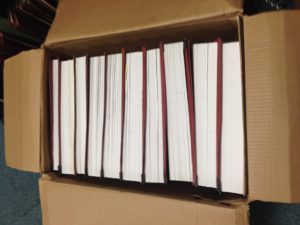
A box of court records from the case. Ricky Langley was tried three times for the murder of Jeremy Guillory. In total, there were roughly 30,000 pages of records.
A description of the research process, from Alexandria:I first watched one of Ricky Langley’s confession videotapes in 2003, as a young law student. Watching that tape challenged who I thought I was– as you’ll read in THE FACT OF A BODY. It also, many years later, ushered in the quest that became THE FACT OF A BODY.
I was haunted for years by what I’d watched on the tape– the little, then, that I knew about Ricky Langley’s story. Details from the confession would come back to me unbidden– details that now appear in the first chapter of THE FACT OF A BODY.
The first set of court records from the case I got was 8,000 pages, and I did so thinking that if I just understood the facts of what had happened, I’d be able to lay the case to rest inside me, and end that haunting. I knew that the reason I was haunted was that it collided with memories of my own past. I thought my task as a lawyer was to be able to cleanly leave my past behind. There were many mysteries my own past held, but I thought that by simply reading what had happened in Langley’s case, I’d be able to see it cleanly, and not through the lens of my own past.
But as I read the files, I slowly realized that I wasn’t the only one who’d seen my life in Langley’s, not the only one who had interpreted his crime through their own pasts. I decided to give the reader of THE FACT OF A BODY my memories, so that the book would recreate the feeling of one mind– mine– piecing together this story, and how it was filtered through the lens of my past. One mind– but my hope is that by inviting the reader into this process for me, how others made stories out of the case becomes highlighted. I had seen my grandfather in Ricky Langley– but others had seen their own family stories in the case, their own pasts and perspectives.
In the years that followed, on many trips to Iowa, Louisiana, I found more files– more boxes like the one you see pictured above. I learned more about Langley’s life– and more about my own. Langley’s story wasn’t just the story of a murder, but a story about how we make stories.
I’ll leave the rest for you to discover in the book, but here is the source note that precedes the text:
***
I have reconstructed Ricky Langley’s life from a mix of public court documents, transcripts, newspaper articles, and television coverage, and in one case a play that was based on interviews. In that extensive record, there were many instances in which I faced two or more competing facts, and I had to choose one in order to fashion a coherent narrative. In many more instances, I decided to include competing facts, claims, slippages, and ellipses, and to hold those contradictions and absences up to the light. More information on sources is detailed in the “sources consulted” section at the end of this book.
For every event I record here, I have at least one person’s statement that it happened and their description of it, or it is a composite event constructed from several different descriptions as detailed in the “sources consulted” section. Wherever I have worked from a transcript, I have edited the dialogue for clarity and pacing. A good portion of the events I write about here occurred publicly and with a great deal of press attention, but I have nonetheless changed some names. The two research trips that form the backbone of the third part of this book were actually many trips that occurred over several years. I have compressed them, but the events depicted on those trips occurred as written.
While I have not invented or altered any facts, relying instead on the documentation I’ve used as the primary source for this book, at times I have layered my imagination onto the bare-bones record of the past to bring it to life. Where I have done so is made clear in the “sources consulted” section at the end of the book. In all cases, what is offered here is my interpretation of the facts, my rendering, my attempt to piece together this story.
As such, this is a book about what happened, yes, but it is also about what we do with what happened. It is about a murder, it is about my family, it is about other families whose lives were touched by the murder. But more than that, much more than that, it is about how we understand our lives, the past, and each other. To do this, we all make stories.